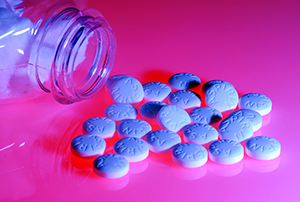by Paula Owens —
The three killer insults on the body are: oxidation, autoimmunity and inflammation. Some level of inflammation is needed for tissue and wounds to heal from infections and injuries; however, when the inflammatory response becomes chronic, problems occur. Chronic inflammation is unseen by the eye and is a silent killer that accelerates aging, prevents fat loss and increases risk of disease.
Many individuals suffer from the consequences of excess inflammation without even realizing it. Inflammation can present as insomnia, pain, allergies, food sensitivities, migraines, skin rashes and more. The cause of every age-related degenerative disease has been linked to chronic inflammation, from diabetes and heart disease to autoimmune and neurodegenerative diseases, including Parkinson’s, Alzheimer’s, stroke and cancer.
Are pain medications and anti-inflammatory drugs the remedy? Actually, no. Pain medications are one of the most overprescribed types of drugs in the U.S. Misuse of prescription and over-the-counter (OTC) pain medication can lead to abuse, addiction and comes with an endless list of serious side effects.
Hundreds of OTC pain relievers and anti-inflammatories are available, such as ibuprofen (including Motrin® and Advil®), acetaminophen (Tylenol®) and NSAIDs (nonsteroidal anti-inflammatory drugs). Americans consume 15 tons of aspirin a day, or 19 billion tablets per year. Although believed to be harmless, a single aspirin will be responsible for 1,500 to 2,000 deaths, is a leading cause of kidney disease and can cause ulcers and toxic headaches. A study in Clinical Gastroenterology and Hepatology found that even low-dose aspirin (75 mg to 325 mg daily) increases the risk of gastrointestional (GI) bleeding.
Regularly taking aspirin also increases the risk of micro-bleeding in the brain by 70 percent. According to the American Journal of Medicine, approximately 107,000 individuals are hospitalized every year for NSAID-related GI complications, and at least 16,500 deaths occur. The side effects from NSAIDs are many, with some very serious.
Managing pain and reducing inflammation
1. Stabilize insulin and blood sugar. This is achieved by eliminating processed, packaged, fast and junk Frankenfoods. Eighty percent of the foods on supermarket shelves did not exist 100 years ago. Eat real food.
2. Heal the gut and correct digestive dysfunction. Gas, bloating and heartburn are signs of an inflamed digestive tract.
3. Rule out underlying infections. These include H. pylori, yeast, fungus, candida, C. difficile and parasites (all of which are more common than not).
4. Determine your food sensitivities, which increase inflammation. The most common offenders: wheat, gluten, sugar, artificial sweeteners, corn, soy and dairy. Even so-called healthy foods can be items your body is sensitive to and the source of hidden inflammation and distress for your body.
5. Eat a nutrient-dense, real food, anti-inflammatory diet. Include plenty of avocado, pastured butter and eggs, coconut and olive oils, wild salmon, fish and seafood, turmeric and ginger, raw apple cider vinegar, leafy greens and non-starchy vegetables, cherries and berries. Opt for grass-fed, free-range and pastured animal protein.
6. Avoid items that encourage inflammation. These include sugar, vegetable oils, trans fats, hydrogenated oils, processed Frankenfoods, soda, wheat, gluten, soy, corn, high-fructose corn syrup, artificial sweeteners, genetically modified organisms, conventional meat and dairy.
7. Optimize and balance the microbiota in the gut. The amount of bacteria and the diversity of bacteria in the gut are directly linked to your weight, risk of disease and overall health. Individuals with low bacterial diversity have higher rates of obesity, dyslipidemia, increased insulin resistance and higher levels of inflammatory markers and white blood cells than those with more diversity.
8. Move your body daily, but exercise intelligently. Too much exercise and insufficient recovery increases inflammation.
9. Get a restful sleep. Make sure you are getting 7 to 9 hours of restful sleep every night.
10. Determine your personal vitamin and mineral needs and deficiencies. Use an integrative and functional blood-chemistry analysis to test C-reactive protein (CRP) and fasting insulin. CRP is used as a marker of inflammation in the arteries. Fasting insulin is a test that screens for diabetes and heart disease, but it is also a marker for inflammation.
11. Stay hydrated. Drink plenty of clean, filtered water and organic green tea.
12. Manage stressors and perceptions of inevitable ones.
13. Try alternative modalties. These might include yoga, tai chi, meditation, acupuncture, hot and cold packs or hot and cold water body emersion.
14. Resolve underlying, subconscious negative emotions.
15. Opt for support from natural therapies. Examples are acupuncture, chiropractic, neuromuscular, craniosacral and myofascial release.
16. Use safe nutritional support for pain and inflammation. Include a combination of any of the following: essential fatty acids, emulsified vitamin D, turmeric extract (curcumin), quercetin, ginger, resveratrol, magnesium, olive and coconut oils, probiotics, proteolytic enzymes, sulfur (MSM), hydrochloric acid (HCL), digestive enzymes and topical Arnica.
Paula Owens, M.S., is a nutritionist and fitness expert with more than 25 years of experience. She is the author of The Power of Four and Fat Loss Revolution and the creator of “21 Days to a Leaner, Healthier You,” an online exercise and weight-loss program. PaulaOwens.com.
Reprinted from AzNetNews, Volume 32, Number 6, December 2013/January 2014.






December 27, 2013
Allergies, Cancer, December/January 2014 Issue, Diabetes, Food, Nutrition and Diet, Health, Heart disease, Inflammation